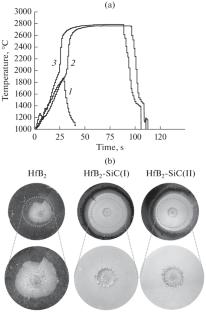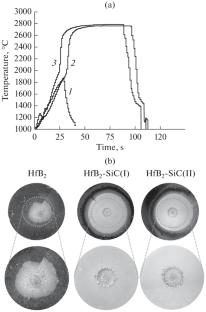热压超高温HfB2和HfB2 - sic陶瓷烧蚀试验
IF 1.2
4区 材料科学
Q4 MATERIALS SCIENCE, MULTIDISCIPLINARY
引用次数: 0
摘要
超高温烧蚀测试HfB2和HfB2-SiC热压陶瓷样品在空气中加热下的火焰燃烧器美联储O2 /乙炔混合在13毫米的距离样品表面已经证明HfB2与30 wt %的碳化硅陶瓷添加剂的晶粒尺寸30 - 50和5 - 10µm和0.25毫克/ s的质量损失更稳定(2066 - 2080°C)与精细HfB2陶瓷开裂温度达到1870°C。所有材料的断裂韧性值基本相当,HfB2-SiC复合材料的硬度略高。本文章由计算机程序翻译,如有差异,请以英文原文为准。


Ablation Tests of Hot-Pressed Ultrahigh-Temperature HfB2 and HfB2–SiC Ceramic
Ablation tests of ultrahigh-temperature HfB2 and HfB2–SiC based hot-pressed ceramic samples in the air under heating in the flame of a burner fed with a O2/C2H2 mixture at a distance of 13 mm to the surface of a sample have demonstrated that HfB2 ceramic with 30 wt % of SiC additive with a grain size of 30–50 and 5–10 µm and a mass loss of 0.25 mg/s is much more stable (up to 2066–2080°C) as compared to additive-free HfB2 ceramic cracking at a temperature of 1870°C. Fracture toughness values are comparable for all the studied materials, and the hardness of HfB2–SiC composites is slightly higher.
求助全文
通过发布文献求助,成功后即可免费获取论文全文。
去求助
来源期刊

Journal of Superhard Materials
MATERIALS SCIENCE, MULTIDISCIPLINARY-
CiteScore
1.80
自引率
66.70%
发文量
26
审稿时长
2 months
期刊介绍:
Journal of Superhard Materials presents up-to-date results of basic and applied research on production, properties, and applications of superhard materials and related tools. It publishes the results of fundamental research on physicochemical processes of forming and growth of single-crystal, polycrystalline, and dispersed materials, diamond and diamond-like films; developments of methods for spontaneous and controlled synthesis of superhard materials and methods for static, explosive and epitaxial synthesis. The focus of the journal is large single crystals of synthetic diamonds; elite grinding powders and micron powders of synthetic diamonds and cubic boron nitride; polycrystalline and composite superhard materials based on diamond and cubic boron nitride; diamond and carbide tools for highly efficient metal-working, boring, stone-working, coal mining and geological exploration; articles of ceramic; polishing pastes for high-precision optics; precision lathes for diamond turning; technologies of precise machining of metals, glass, and ceramics. The journal covers all fundamental and technological aspects of synthesis, characterization, properties, devices and applications of these materials. The journal welcomes manuscripts from all countries in the English language.
 求助内容:
求助内容: 应助结果提醒方式:
应助结果提醒方式:


